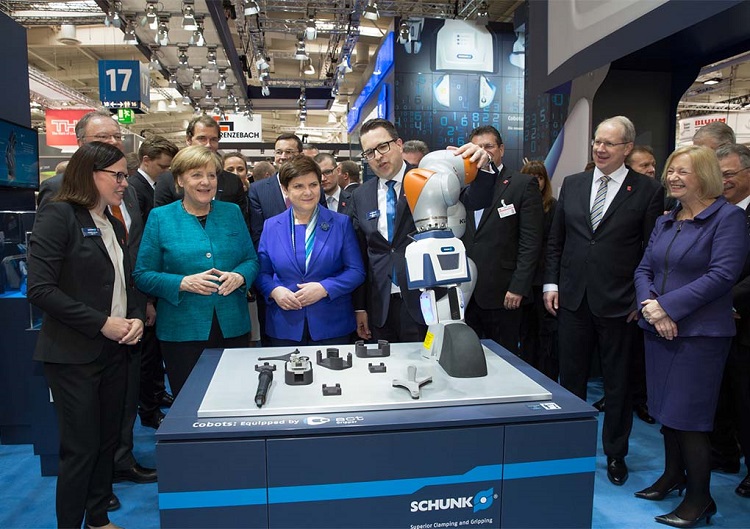Angela Merkel visited the SCHUNK pavilion at Hannover Messe and learned about the future of smart production
SCHUNK, the competence leader for gripping systems and clamping technology of Lauffen, Germany started off the Hannover Messe with a brilliant success: At the opening of the world’s leading trade show by Germany’s Chancellor Dr. Angela Merkel, Prof. Dr. Johanna Wanka presented the innovative family-owned company with the Hermes Award 2017, one of the world’s most prestigious technology prizes. On her tour of the exhibition on Monday, Chancellor Merkel visited the SCHUNK booth, and looked on while the Managing Partner/CEO of the family-owned company, Henrik A. Schunk, presented smart gripping modules that enable direct human/robot collaboration (HRC). With its HRC grippers of the SCHUNK Co-act series the Swabian technology forge has made an important contribution to production systems of the future.
The company received the Hermes Award for the SCHUNK JL1 Co-act Gripper, the world’s first intelligent gripping module for human/robot collaboration that directly interacts and communicates with humans. Henrik A. Schunk sees the award as a milestone in the history of the group of companies: “My team and I are proud of the success of the SCHUNK JL1 Co-act Gripper, which is a decisive step on the way to highly flexible handling scenarios for Industry 4.0 and therefore for smart production.” For the first time in the history of the Hermes Award, the prestigious trophy was awarded for a gripping module. The award was given at the recommendation of an independent jury headed by Prof. Dr. Dr. h. c. mult. Wolfgang Wahlster, Chairman of the Management Board of the German Research Center for Artificial Intelligence (DFKI). In 2015, SCHUNK had made it among the top five for the Hermes Award, and therefore was at the leading edge of technological innovation, back then with SCHUNK eGRIP, a web-based 3D design tool for additively manufactured gripper fingers.
Intelligent robot gripper
In recent years, the leading supplier of technology for robots and production machines has been driving the digitalization of industrial production with its smart components. Within the world’s most comprehensive spectrum of gripping systems and clamping technology with more than 11,000 standard components, the SCHUNK JL1 Co-act Gripper defines the peak of what is technologically possible. The HRC gripper, developed with the guiding principle of Industry 4.0 in mind, features a decentralized control architecture, which was designed according to the RAMI 4.0 guidelines. Like no other gripping module it uses its exposed position “closest to the part” and “closest to the human” to achieve maximum efficiency and functionality in human/robot collaboration. Complex sensor systems and artificial decentralized intelligence, which are fully integrated in the gripper, allow it to constantly gather information about the component being gripped and about the environment, to process this information and to execute appropriate responses based on the specific situation. For this purpose, the gripper is equipped with innovative kinematics, which enable both parallel and angular gripping. This allows maximum flexibility in the handling of alternating component variants. Tactile sensors in the fingers monitor the gripping process to ensure reliability and adapt the gripping parameters independently to prevent damage to sensitive components. Specially developed gripping strategies allow the sensitive gripper to adapt its behavior in real time, depending on whether a workpiece or possibly a human hand is gripped.
Safety aura for collaboration with humans
The intelligent gripping module paves the way for highly flexible HRC scenarios in modern production processes. Compared to existing solutions the SCHUNK Co-act Gripper is designed for much higher diversity and flexibility. The integrated safety aura allows unlimited use and handling capabilities of the robot in the direct vicinity of humans. Separating safety devices are unnecessary. All situational, environmental and operating conditions are monitored by means of several “senses”. An integrated miniature PC immediately analyzes process data in order to respond virtually in real time and also as a basis for self-learning. The gripper enables automation of tasks that previously were performed manually, therefore boosting efficiency. At the same time, the inline data acquired from the production cycle and derived information can be sent continuously to higher level systems for constant improvement or control of the processes.


